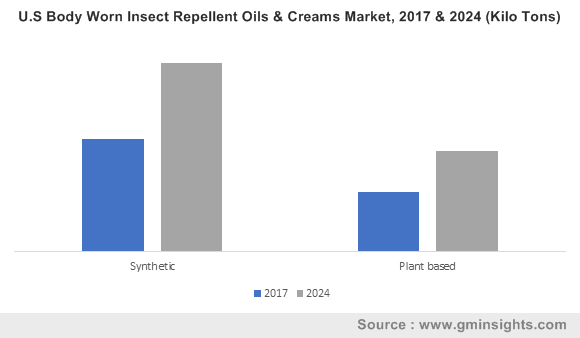Body worn insect repellent market to accrue heavy returns via supermarket and hypermarket distribution channels, global industry valuation to surpass billion-dollar benchmark by 2024
Publisher : Fractovia | Published Date : June 2018Request Sample
Touted as one of the fastest emerging niche verticals of bulk and specialty chemicals industry, the commercialization scale of body worn insect repellent market has been directly proportional to the rising menace of bug-borne diseases globally. Out of all the diseases that are caused by insects, mosquito is regarded to spread the most fatal ailments such as Malaria, Chikungunya, Yellow Fever, and Dengue. While analyzing the global disease burden and the recent trends afflicting the healthcare sector of various nations, World Health Organization's World Malaria Report 2017 notes that a total of 91 countries reported around 216 million cases of malaria in the year 2016. This is apparently a humongous increase of 5 million cases over the previous year and the global tally of deaths reached a staggering number of 445,000 which is about the same reported in 2015. These statistics are proof enough of the significance held by business verticals like body worn insect repellent industry in decreasing the overall mortality rate pertaining to vector-borne diseases around the globe.
U.S Body Worn Insect Repellent Oils & Creams Market, 2017 & 2024 (Kilo Tons)

Supermarket and hypermarket segment to capture a significant portion of the overall distribution channel space of body worn insect repellent industry
With the major firms partaking in body worn insect repellent market focusing on extending their product portfolio across various distribution channels, the supermarket and hypermarket segment is estimated to grow at an impressive CAGR of 8% over 2018-2024. This particular distribution segment holds a wide presence across urban and semi-urban regions and provide hundreds of brands at economical price. Moreover, the practice of bulk purchase by these supermarkets complemented with their large storage facilities ensure access to various products under one roof.
Elaborating further, it would be prudent to mention that the supermarket and hypermarket segment offers a variety of insect repellent solutions such as lotions, liquids, creams, and sprays which are well-suited for direct skin application and can also be applied on almost all apparels we well. Even though the prominence of online stores has been increasing in the past few years, the size and volume of product storage has extended an upper-hand to the supermarket and hypermarket segment in the overall distribution channels of body worn insect repellent industry.
Due to the rising awareness regarding the numerous benefits of utilizing natural or organic products, the plant-based insect repellents have found increased preference across various regions. Formulated with natural oils such as lavender, soybean, citronella, and eucalyptus, the plant-based insect repellents have proved to be more effective than conventional insect repellent alternatives. Apparently, the plant-based insect repellent products are forecast to witness rapid growth in the ensuing years. In fact, as per a research report put together by Global Market Insights, Inc., the plant-based insect repellent segment apportioned over 36% of the total revenue share of body worn insect repellent industry in the year 2017.
Even though the growth prospects of body worn insect repellent market appear highly promising, there exist certain stumbling blocks that would consequentially hamper the rapid product penetration in the forthcoming years. It has been observed that some insect repellent solutions have caused skin rashes and breathing complications in the patients. Moreover, unpleasant odor by cream formulations has further caused discomfort among children and the chemical droplets emitted by pressurized containers have also created fears of breathing problems in adults. However, the aforementioned challenges are likely to be addressed in the times to come owing to the fact that major body worn insect repellent industry contenders have been spending substantially on research activities that would assist them in manufacturing new solutions addressing the consumer demand.
Stringent regulatory guidelines being framed by government agencies such as Environment Protection Agency (EPA) and Food and Drug Administration (FDA) coupled with the swiftly enhancing repellent technology would undoubtedly propel the remuneration portfolio of body worn insect repellent industry. Driven by persistent development on the product front, the overall revenue collection of body worn insect repellent market is slated to exceed USD 1 billion by 2024, as per reliable estimates.